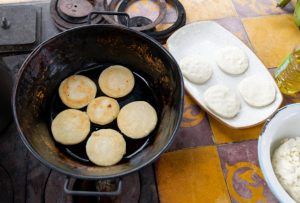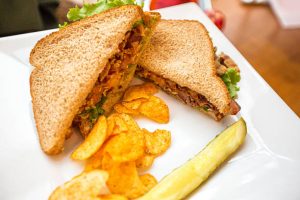
Have you ever wondered where certain foods come from? What is the origin of its name? This is the first article in a series that will give you an overview of where some food and drinks come from, their country of origin, and the name they have.
Today’s article is about stuffed vegetables and leaves. They are the most popular dishes on Arab tables, particularly the Egyptian, Levantine, and Iraqi Dolma, the Turkish equivalent of Mahshi, or the stuffed vegetable. This tour will review the history and origin of Mahshi.
What is Mahshi, or Dolma?
Mahshi is an Arab dish popular in Turkey and many other Arab countries. In Turkey, it is called ‘Dolma. The main ingredients of the word are vegetables that have been stuffed either with rice or minced meat.
The name
Mahshi is Arabic for stuffed. In Egypt, this dish is known by the name Mahshi. Different words in different countries call this dish. It derives from the verb “stuffing” or “filling.” In Turkey, for example, it’s called “Dolma,” the Turkish equivalent of “stuffed.” The word ‘Dolmak,’ which means ‘to stuff’ in Turkish, is the source of this dish. The dish is known as Dolma in Iraq. In Turkey, the dish is also known as sarma ‘. The word ‘Sarmak,’ which means to wrap in Turkish, is the origin of this dish.
The Origin
There are many stories about the origin of this dish. Everybody wants to attribute the history of this food to their country or city. Many stories have been told about this. The majority of current accounts relate this food to Turkish Cuisine. The Egyptians and Levantines, however, strongly disagree with this opinion. According to the well-known narration, this dish has history dates back to Ottoman Cuisine. During the Ottoman period, the Turks brought this food to the Arab world. This theory claims that the first “stuffed dish” was served to the Egyptians at the palace of an Ottoman governor.
Now and then, the Ottoman governor would gather with the princes and rich of Egypt in his palace. One time, ‘dolma” was served at the feast. The princes and notables, however, were afraid to try this food. The princes and dignitaries feared he might kill them by poisoning the leaves. They did not eat this food. When the Ottoman Governor noticed, he began eating from it and gave it to them. The taste was good, and they quickly spread it to the public.
A second narration states that Mahshi first reached the Arab area during the Seljuk rule by the Islamic state between the 11th and 12th centuries. The Turkish origins of some of the current names in these regions support both opinions. The Azerbaijani stuffed dish, one of six independent Turkish states, on the list of world cultural heritage by UNESCO confirms that claim.
If we look deeper, we’ll find many stories and opinions about the origins of food. It has been on the table of Mediterranean Countries for centuries and was even mentioned in medieval Arabic books. The Greeks are also credited with the invention of this dish, as they served their version of stuffed vegetables and leaves in ancient Greek cooking. Thrion is fig leaves filled with sweetened cream cheese.
Mahshi or Dolma is a Favorite Dish
Mahshi, a famous special dish in Arab countries such as Egypt, has a special place at the Egyptian table. You must always find a plate with stuffed leaves or vegetables on the table when someone invites you over for lunch. It shows that the host is grateful.
This dish is a favorite of both the stomach and the heart. The final product is worth the hours and effort it takes to prepare. It’s delicious and flavourful. Turkish versions are also excellent regarding the variety and quality of the stuffed leaves and vegetables. The Turkish version was the same, as they excelled in the types of stuffed vegetables and leaves and their fillings.
Mahshi or Dolma Stuffings
Different types of stuffing depend on whether it is a vegetable or a filling exist. Regardless of their origin and where they are spread, all kinds of stuffing have a delicious taste.
We can see the many classifications of the Turkish stuffed “Dolma” and its diverse ingredients. It is not a fundamentally different food, and the food remains the same. Both dishes are made with minced meat or rice, but the main ingredient is bulgur. We will now present some delicious forms of stuffed Leaves or Dolma.
Stuffed Grape Leaves
In Arab countries and Turkey, grape leaves are a popular and tasty stuffed dish. Grape Leaves are a vegetable that is rich in nutrition. It’s called Stuffed Grape Leaves or Mahshi Wara’ Inab in Egypt. In Syria, it’s called Yaprak – a Turkish term meaning paper. In Turkey, the dish is known as Sarma.
The grape leaves are boiled for several minutes in water while the fillings are prepared. As mentioned, the filling differs depending on where you are. The filling can be meat mince or grains like rice or bulgur. It is then stuffed with rice, bulgur, or soup and cooked on the stove.
Cabbage Rolls
In Egypt, Stuffed Cabbage and Lahana sarmas are other types of stuffed leaves eaten in winter. The heart muscle is very healthy when you eat stuffed cabbage.
The Turkish version of the cabbage roll is different than the Egyptian version. The preparation is the same, but they use minced meat instead of rice. The cabbage leaves are boiled in water and then filled with the stuffing. This includes rice, bulgur (a type of grain), parsley, mint, onions, tomatoes, and minced meat. The cabbage leaves are rolled and placed in the pot. To help the rolls cook, water and tomato sauce are added.
Stuffed Peppers
In many countries, stuffed peppers are popular. It is rich in vitamins and nutrients and has a delicious taste.
To begin, prepare the filling using minced meat, rice, or both, along with parsley, tomatoes, onions, and other ingredients. Then, stuff the peppers. Lastly, water and tomato juice are added until the peppers are cooked.



